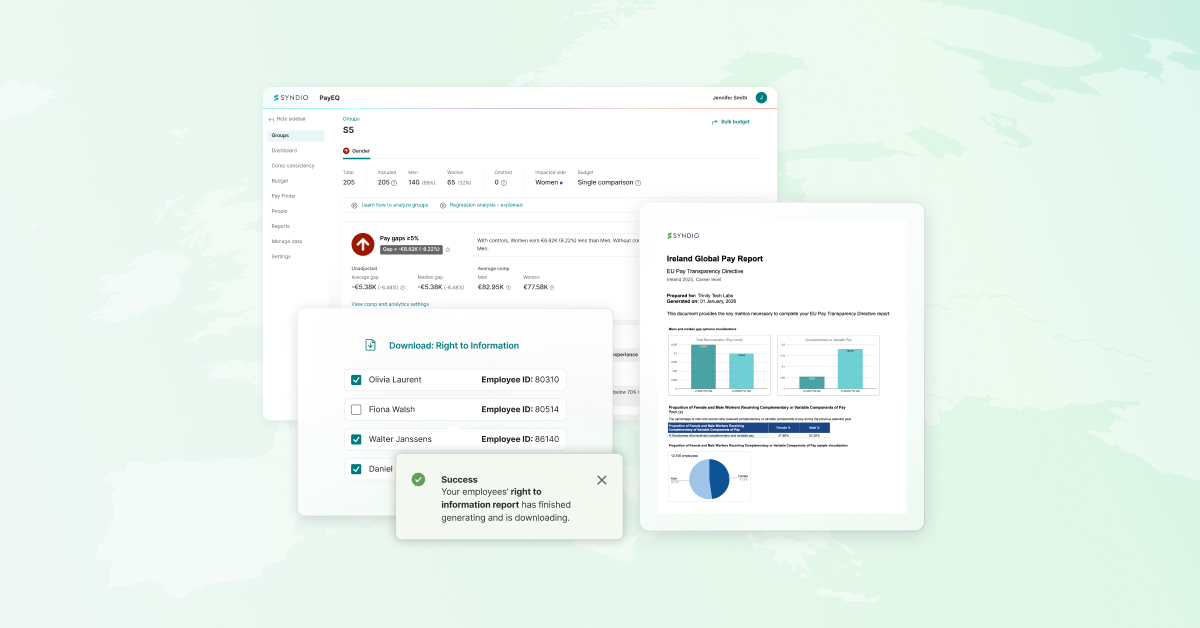Workplace transparency is riding a wave of change into the new year, with the greatest disruptor being the European Union’s passage of the EU Pay Transparency Directive.
The Directive is not just a regulatory change — it’s a harbinger of a new standard in workplace transparency, demanding unprecedented openness in both pay and career progression. It also requires a new, cross-functional look at pay equity, examining gaps not only within groups of employees performing equal work, but also looking at opportunity gaps. As we navigate these changes, we predict that the ripple effects of the EU’s initiative will be felt worldwide, influencing policies and corporate practices far beyond Europe’s borders. Global cross-pollination is the name of the game.
In parallel, the momentum in the United States and Canada, with their own significant strides in workplace transparency laws, suggests a global shift towards greater transparency in the workplace. Below, we explore the trends that developed in 2023 and what that means for the year ahead.
1. Pay transparency will be a continued trend.
With the adoption of the EU Pay Transparency Directive, pay scale disclosure will be coming to Europe in 2026 or before. We expect this to have a major impact on Europe, as we have already seen in the U.S. This year there were also an increasing number of pay scale disclosure laws in Canada, and more laws are on the horizon there.
It has been remarkable to watch the impact of the pay transparency laws in the U.S. this year, following the wave of pay transparency laws passed last year. While these laws did not pass in the U.S. this year at the same breakneck rate as we saw in 2022, the United States saw pay scale disclosure laws adopted in two new states in 2023: Illinois and Hawaii. And I suspect we may see more pay scale disclosure laws adopted soon in major markets in the U.S., as Massachusetts, New Jersey, Maine, and Washington, D.C. still have laws moving through the legislative process.
The study I kept coming back to again and again this year was one from Indeed, which found that, while in February 2020 only 18% of job listings in the U.S. had employer-provided salary information, by August 2023, that number had risen to over 50% (a 178% increase!). And disclosure rates are much higher in major centers of commerce like NYC and California. I cannot remember a workplace equity law that had such an impact on the daily lives of employees and the day-in-day-out work Total Rewards, Legal, and HR teams as we have seen with these pay scale transparency laws. And as we leave 2023 and look forward to 2024, the Syndio team is charged up to help navigate this new landscape with you.
Stay up-to-date with the U.S. U.S. Pay Scale Transparency Legislation Cheat Sheet >
2. Opportunity transparency is accelerating.
In 2023, Colorado, Illinois, and the European Union passed laws broadening the conversation about workplace fairness to include transparency around opportunities for promotion and career growth with the goal of closing the representation gap in leadership and management positions.
While this still feels like a ripple, as compared to the wave of pay scale transparency laws, I believe this will be a continuing trend as we move into 2024 — and one that could be as transformative as pay transparency laws have been. This ripple will be amplified by the wave of mean and median pay gap reporting, which at their core are less about pay equity and more about opportunity transparency.
Learn more in the Opportunity Transparency Legislation Cheat Sheet >
3. Median and mean pay gap and other pay reporting was a key focus in 2023 — and more is on the horizon.
With the passage of the EU Pay Transparency Directive, it will soon be compulsory for employers in the EU to assess, remediate, and publicly report on gender pay gap results.
You might have less time than you think to prepare for the EU Directive. The first report will be due 7 June 2027, which might feel a long ways off. But because the first report will be based on compensation earned in 2026, that means that you only have — at most — two compensation cycles to incrementally correct issues before they become part of your public pay reporting. The time frame is also shortened because employers will have to rethink how they are grouping employees under the EU Directive. The groupings will not just be comparing employees doing the same or similar job but comparing employees doing “work that is of comparable value to the organization”. Testing and iterating to ensure your groupings make sense can take time.
A similar focus on the median pay gap is seen in the U.S. This May, for the first time, California required that employers report mean and median pay gaps by EEO-1 category. And Illinois began to require pay reporting. We are likely not done yet. Massachusetts has a pay reporting law moving through the legislature.
And this is happening all around the globe. For example, updated reporting obligations kicked in 2023 in Japan and Brazil adopted new pay reporting transparency provisions with the first report due in Brazil in March. More is on the horizon.
Is unadjusted pay gap reporting coming to the U.S.? Dive deeper >
4. Discipline or discharge transparency is a new development.
A new transparency trend we see emerging is discipline or discharge transparency, with laws in the U.S. introduced in 2023 making this one to watch. For example, a bill introduced in NYC that failed to progress this year would have required fast food employers to provide a written explanation to employees of the precise reasons for their discharge including a copy of any materials, personnel records, aggregated data, or assessments that the employer used to make the discharge decision. Keep an eye on this trend in 2024.
Embracing the future: Data-driven transparency in the workplace
It’s clear that we are entering an era where data isn’t just valuable — it’s vital. For HR leaders and Total Rewards teams, the sweeping changes brought on by the EU Pay Transparency Directive and other pay and opportunity transparency requirements worldwide signal an urgent need for a proactive, data-driven approach as transparency is not going anywhere.
To stay ahead of the curve, businesses must move beyond just identifying areas for improvement and towards building a story of improvement and incremental success. The key is to use data to inform decisions, track progress, and communicate effectively both internally and externally. In this rapidly evolving landscape, those who embrace data and transparency will not only foster a more equitable workplace but also build a strong foundation for sustainable business success in the years to come.
The EU Directive deadlines may seem far off, but companies need to start preparing now. Get a sample timeline for preparing for the EU Directive at the link below.
The information provided herein does not, and is not intended to, constitute legal advice. All information, content, and materials are provided for general informational purposes only. The links to third-party or government websites are offered for the convenience of the reader; Syndio is not responsible for the contents on linked pages.



